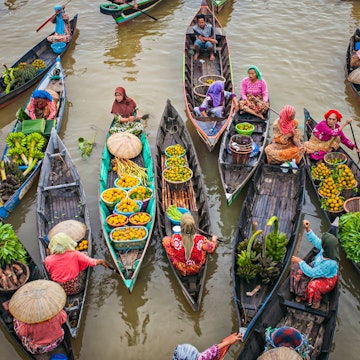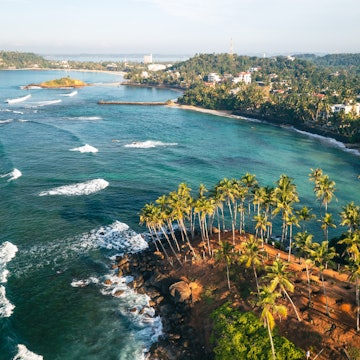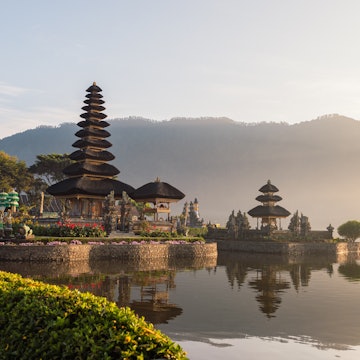

A week in Bali is enough time to take in surf hubs, green rice terraces, temples and volcanoes. Mazur Travel/Shutterstock
For many travelers, Bali offers a first taste of Southeast Asia’s gorgeous tropical islands. Amid lush, green vegetation and wafting palms, you’ll find stunning surf beaches, lavishly spiced cuisine, buzzing traveler hubs, fascinating festivals and timeless temples. But with so much to see on this lush tropical island, where do you begin?
To point you in the right direction, this seven-day itinerary takes in the highlights of Indonesia’s favorite island escape, from the hedonistic, surf-washed beaches of Bali’s southwest coast to serene Ubud – the "other" Bali, rich in culture, history and temples – ending on the east coast in the diving playground of Tulamben.
When to arrive
During Bali’s high season months of July, August and December, crowds swell and prices soar, but there’s a lively buzz across the island. July and August are the driest months, with optimal weather for exploring and good surfing conditions, while December is often damp and cloudy but still warm and very busy with travelers escaping the cold back home (or taking advantage of their Christmas leave).
Temperatures stay warm year-round, with the average temperature only occasionally dipping below 27°C (81°F). For a calmer experience of Bali, the shoulder season months of May, June and September hit the sweet spot, with lower prices, only moderate rainfall and smaller crowds.

How to get from the airport
Bali’s international airport, I Gusti Ngurah Rai, is about 13km (8 miles) outside Denpasar, and this is where most people arrive, though some travelers come by ferry from Java and Lombok. Pre-booked and regular taxis, rideshares and buses can get you to Denpasar in around half an hour, or directly to traveler hubs on the coast.
How to get around
Traveling by rented car – either under your own steam, or with a hired driver – is the most convenient way to explore the island. Local minibuses known as bemos are cheap but infrequent and they don’t go everywhere. An alternative is to get around by tourist shuttle bus, taxi or rideshare, via the Grab and Gojek apps – there are no huge distances to cover in Bali. Or, if you’re feeling more ambitious, scooters are widely available for rent (just make sure you're covered by your travel insurance).
What to pack
Whenever you come, it’s going to be warm, so pack thin, cotton clothing, ideally with some outfits that cover your arms and legs for trips to temples and religious sites. You’ll want swimwear for the beach, and a sarong (available locally) for covering up when you leave the sand.
November to March is the wet season, but there’s a chance of rain at any time, so bring a thin raincoat or umbrella and keep it handy. Also bring some warmer layers to combat powerful air-conditioning, and bug repellent to keep off mosquitoes.

Day 1: Travel from Denpasar to Canggu
Go from Denpasar to Canggu: Most visitors don’t linger in Denpasar, Bali’s boisterous capital, though there is good shopping and eating for those who do. A taxi or rideshare can take you directly from the airport to Canggu, where you can kick off your shoes and head straight for the sand or the pool.
How to spend the day: Buzzing Canggu is as much a state of mind as an area. This strip of Bali’s west coast is lined with beaches, some great for surfing, such as lovely, black-sand-covered Echo Beach (Pantai Batu Mejan). The Canggu area also hosts an ever-growing number of boutique hotels and guesthouses, villas for rent, cool and creative cafes and hip restaurants; it’s little wonder many visitors stay for days.
Set aside some time to swim in the warm waters of the Indian Ocean and get your bearings (ideally with a fresh coconut in hand). Then, as the afternoon wears on, follow the Canggu Beach Walk, taking you from Batubelig Beach to Echo Beach in a couple of hours. It’s a great way to get a feel for this tropical getaway.
Evening: Canggu is a good spot to start exploring typical local cuisine. Varuna Warung is a favorite stop for traditional Indonesian fare; choose off the menu or eat local masakan padang food – a variety of spicy dishes served buffet style, with plenty of vegetable options.

Day 2: Take a yoga and surf day in Canggu
How to spend the day: With a second day to play with in Canggu, start the day with a morning yoga session. Yoga centers along the coast offer something for everyone, from beginners to lifelong yogis, and hippies to Instagrammers.
Near Pantai Nelayan, family-owned, permaculture-based Serenity is a down-to-earth yoga resort offering eight daily class times, including sessions of aerial yoga. Samadi Bali is a peaceful yoga and wellness center, with a boutique and its own eco-conscious supermarket on busy Jl Padang Linjong.
Another popular space, The Practice might appear contemporary in style, but all of its classes are rooted in traditional Hatha yoga practice. You’ll find it on Jl Batu Bolong.
After lunch, hit the breaks. Surf shacks can rent you a board, or you can book a lesson with a surf school such as Canggu Bali at Pantai Berawa, where waves that are good for both beginners and more experienced surfers break onto a black sand beach. Echo Beach and Pantai Batu Bolong are also good spots.
Evening: A second night in Canggu provides an opportunity to sample Bali’s famous babi guling (spit-roasted suckling pig), an unapologetically carnivorous indulgence. Many warungs (informal local restaurants) specialize in this dish – you’ll recognize them from the image of the skewered pig that hangs outside. Babi Guling Men Lari on Jl Bypass Tanah Lot is widely accepted by Canggu residents to be one of the best in the area.
Once fed, sample Canggu’s party scene at Finns Beach Club, a pulsating all-day party venue that extends the pure hedonism late into the night. DJs and vocalists set the vibe as revelers order drinks from swim-up bars, roller-skaters wearing retro hot pants weave between Finns’ four pools, and figures with glitter balls for heads dance up a storm.

Day 3: Take Bali’s spiritual and cultural pulse in Ubud
Go from Canggu to Ubud: The drive from Canggu to Ubud takes about an hour, but set off early as there’s loads to see when you arrive.
How to spend the day: Ubud is a place where Balinese traditions imbue every waking moment, where colorful offerings adorn the streets and where the hypnotic strains of gamelan (Indonesian traditional orchestra) music provide an ever-present soundtrack to everyday life.
Ubud is easily explored on foot or bicycle, so check into your accommodation, then set off to explore Bali’s beating artistic heart. In this lush and green sprawl of tropical river valleys, temples, guesthouses, wellness centers and tumbling rice terraces, a holiday of a few days can turn into a stay of weeks, so be ready to extend your stay if the fancy takes you.
Use your first day here to explore Ubud’s royal and religious heritage, starting at the city’s surprisingly modest royal palace and its flanking temple, Puri Saren Agung; most of its structures were built after the 1917 earthquake, and the local royal family still lives here.
Ubud has dozens more temples, but many are closed to non-Hindus; carving-covered Pura Taman Saraswati is the most picturesque temple that’s always open to the public. Waters flowing from the rear of the large site feed a pond in front, which overflows with lotus blossoms.
Just west of the center, down by the start of Jl Raya Campuan, Pura Gunung Lebah sits on a jutting rock at the confluence of two tributaries of the Sungai Cerik river. Far below street level in a lush gorge, the setting is magical.
Evening: Taking in a show of traditional Balinese dance at sunset is de rigueur in Ubud. For a classic and atmospheric experience, Ubud Palace is one of the most popular venues, with elaborate traditional performances in an ornate royal courtyard. The Pura Dalem Ubud temple makes the most of its sacred setting, with flame-lit backdrops enhancing the intensity of performances of traditional dance forms such as Kecak.

Day 4: Enjoy a day of culture, yoga and landscapes in Ubud
How to spend the day: With a second day in Ubud, there’s time to dig deeper into the local culture and immerse yourself in its tropical landscapes. The modern Balinese art movement started in Ubud and the town is dotted with culturally important art museums.
The Museum Puri Lukisan is the most enjoyable museum, even if your interest in art is limited. It’s set in lovely, tiered gardens that are alive with water features, and four buildings display works from all schools and periods of Balinese art.
The Agung Rai Museum of Art (ARMA) is another must-see museum. Founder Agung Rai built his fortune selling Balinese artwork to foreigners in the 1970s, and during his time as an art dealer, he acquired one of Indonesia’s most impressive private collections of art.
After lunch in one of Ubud’s cool cafes, you have multiple options. You could book into a local spa such as hippie-vibed Ubud Sari Health Resort or cool Taksu for an afternoon of relaxing indulgence. You could feel the energy flow with a yoga class at the respected Yoga Barn, offering a vast range of classes in many different yoga traditions.
Alternatively, you could take a walk along the Campuhan Ridge for impressive views, rent a bike to cycle to surrounding villages through the lime-green rice fields, or head to Tegallalang for epic views over the tumbling Ceking rice terraces. Look for gaps along the road not yet filled by cafes and savor the view of the sinuous ribbons of green without the hustle.
Evening: Combine dinner with a traditional show of Balinese shadow puppetry. The very central Bali Culture Workshop at the Oka Kartini BnB stages popular evening shows. For food, graze the local warungs; Warung Pulau Kelapa has a huge menu of authentic dishes drawn from across Indonesia, plus sensational sambals (Indonesian-style chili pastes). Alternatively, a cheery family crew dole out spicy Indo classics with silky smooth satay peanut sauce at Mama’s Warung at Jl Tebesaya No 29.

Day 5 & 6: Climb towering Gunung Agung
Go from Ubud to Gunung Agung: Drive north of Ubud for 10km (6 miles) to see the photogenic Ceking rice terraces (if you didn’t see them yesterday) before veering east to Gunung Agung, an active volcano that’s Bali’s highest and most revered peak.
How to spend two days: If you’re fit and keen – and the volcano is not currently erupting – you can climb the steep, forested slopes of 3142m (10,308ft) Gunung Agung for sweeping views. Scaling the peak takes you through a verdant forest in the clouds, and most visitors hike the trail at night to be greeted by sweeping dawn views from the summit.
It’s best to climb during the dry season (April to September); at other times the paths can be dangerously slippery and the views are typically clouded over. Check the eruption status of the volcano before attempting the climb.
The easiest route up Gunung Agung begins from the temple at Pura Pasar Agung, taking at least three hours one way, but there’s a steeper and tougher route from the temple complex at Pura Besakih. Various lodges and guesthouses around Sidemen and Tirtagangga offer rooms and can arrange a guide and transfers to the trailheads.
Before or after you climb to Gunung Agung’s summit, there should be time to explore the wonders of Pura Besakih, a complex of 23 Hindu temples set high on the southwest flank of the volcano. This is Bali’s most important religious site and processions of villagers arrive constantly for ceremonies and blessings, taking holy water back to their own village temples.
Many of the temples here only admit Hindus but visitors can walk among the various shrines, and the scores of jet-black meru (temple towers) soaring towards the sky are a moving and dramatic sight. Visitors get a ride up the long hill to the temple complex in an electric cart, starting from a dedicated parking area near Sidemen.
Evening: Most people eat where they are staying; Tirtagangga has a better selection of warungs than Sidemen.

Day 7: Head for the wrecks and reefs of Tulamben
Go from Gunung Agung to Tulamben: After a second night near Gunung Agung, travel northeast to Tulamben, one of Bali’s hottest diving destinations, a journey of about 1½ hours.
How to spend the day: Tulamben is a diving hotspot, thanks to the WWII wreck of the USAT Liberty, a US Army cargo ship torpedoed by a Japanese submarine in 1942. It’s perfect for snorkelers, too. The wreck's stern rears up from the depths, encrusted in coral and swarming with dozens of species of colorful fish.
After a wreck trip, you can stay overnight in one of the local dive resorts, or head northwest around the coast to laid-back Lovina to laze on the beach or take a dolphin-spotting trip – a perfect end to a week exploring Bali’s highlights.
This article was adapted from Lonely Planet’s Indonesia guidebook from July 2024.
















